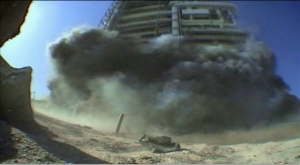Shooting a 3D documentary: review – Film Factory 3D Beam Splitter Indie Rig
Our crew’s spent the last week testing the B cam system we hope to use to shoot our first 3D documentary.
Here’s what we’ve learned about the Film Factory 3D BS Indie Rig:
Pros
1) Relatively affordable: rings in at $3,895 US plus shipping and handling (we also bought an extra mirror in case the first one smashes in the field. Don’t think we’ll find a second lying around at the condemned sports stadium slated for explosive demolition in Salvador, Brazil, where we’re going to be filming, and shipping one in would surely be a nightmare).
2) Robust but adjustable: the rig’s sturdy, so I think it will stand up well in the field. But luckily the structure isn’t rigid – we’ve had some difficulty lining our Sony EX1 and EX3 up properly (see: large and cumbersome … it’s a problem), so we’ve disassembled the rig, manually repositioned parts, and tightened them to try and accommodate the cameras.
Specifically, the aluminum rails are locked in with screws that can be loosened, adjusted, and locked back in. Without this flexibility we’d have no hope of effectively adjusting the heights of the cameras relative to the base rail (which we’re still working on. Argh).
Cons
1) Manual operation: It doesn’t have all the fine, automated controls that the higher-end feature film rigs do. It lacks motorized components, so factors such as interaxial distance and convergence have to be adjusted manually. In feature film production, it’s often one person’s job just to operate the remote to make these adjustments on automated units.
2) Heavy load: This is just something the crew’s going to have to get used to – 3D shooting demands so much more gear. But it’s still a downer. Total tally: the rig, a tripod, two mid-sized cameras, the nano3D recorder, the Transvideo Cineform 3D Monitor, all the sync cables, and battery. We think it may take two extra bodies in the field just to move all of these components around.
And the cameras are a whole other story … more to come on the Sony EX1/EX3 issue.







